
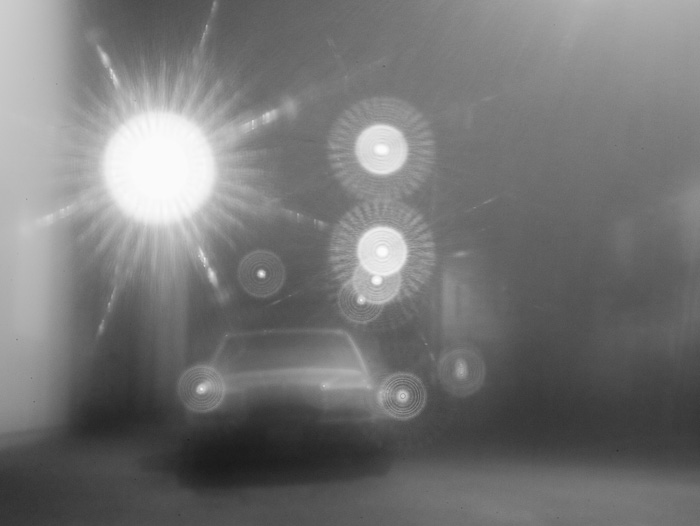
Canon 5D Mk II, Lensbaby Composer with Zone Plate. ISO 2500, 6 seconds @ f/19.
This is the second year that Photographic Center Northwest, our local photo school, has put on a 24-hour photography marathon as a fundraiser. It’s also the second year I’ve participated.
The premise is simple: start shooting at 6pm on Friday night and try to last through 6pm on Saturday night. You raise funds by taking pledges, and at the end of the event submit photos for a juried show. Everyone gets one image selected, and the donated prints are auctioned off.
Last night was Long Shot night. I met up with 7 other photography friends and we started our evening with dinner at Via Tribunali. Nutella calzone? Delicious!
I lasted until around 3am this time. Somewhere during the evening I managed to pick up yet another cold, after just recovering a few weeks ago from my last one. Not fun. I spent most of today lying on the couch sneezing instead of shooting. Oh well.
The evening got off to a slow start as the sky was cloudy, it was raining lightly, and the light just wasn’t interesting. But crouching in a side street in Georgetown in south Seattle, I snapped the above photo and instantly knew it was the shot for the evening. It’s such nice feeling to get a great image early.
Have you ever participated in a marathon photo session?
David, Vlad, and newcomer Teresa are headed to the Washington Coast on Memorial Day weekend. I’m really excited to head back there to try and complete my series of images for a new folio. Prior to the trip I’m planning on taking some ideas from the John Paul Caponigro workshop I attended to really think through the types of images I need to complete a full story.
I’m aiming for a folio of 7 images, and right now have 19 to pick from. That may sound like a lot, but honestly because they wre just random shots on the beach it’s tough to find 7 that work as a story. I have a lot of variations of essentially the same shot in that 19. I’m hoping that by pre-planning and even sketching out what I’m after will help. It will be weird: I’ve never pre-sketched images before.
Have you ever done pre-visualization through sketching before a shoot? What was the result?

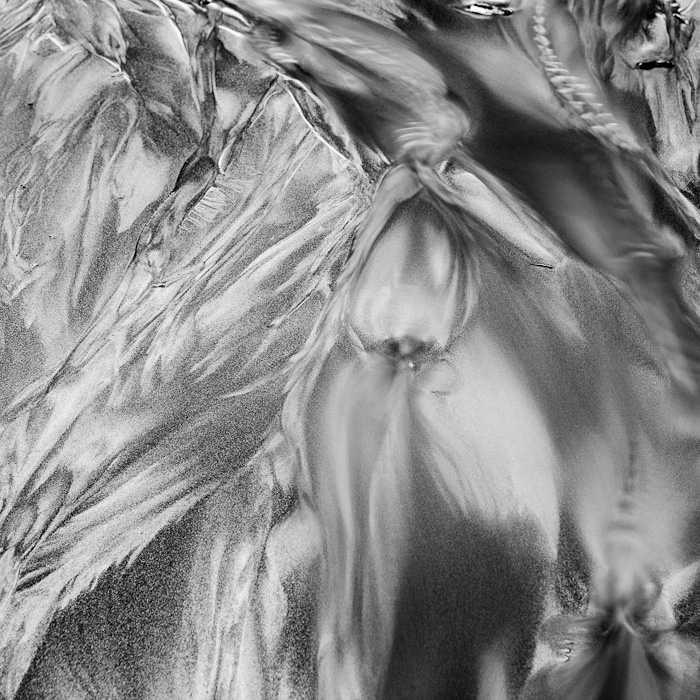
Canon 5D Mark II with Canon 24-70 f/2.8L. 70mm, ISO 100, 67 sec. at f/8.
The above photo is from back in December when I made my first dedicated photo trip to the Washington Coast with David and Vlad. We had one very rainy day where a 20 minute hike to Second Beach seemed like it would be a waste. But then David saw a pretty patch of sand, and next thing you knew the three of us were shooting a 4×8′ patch of sand like crazy.
That one little shooting session resulted in a second trip a few months later to the same beach location. A third trip is in the works.
Why is one little patch of sand so interesting to me? Because I want to use it to build a folio. Unlike other folios I’ve produced, I want this folio to tell a story instead of being a collection of pretty images. I’m working on pulling together 7 images using the techiques John Paul Caponigro outlines in his Photo Essays creativity lessson. Right now I have about 20 good images to select from. I figure I need at least double that before I have enough to come up with the folio images.
More importantly, though, I need to pre-think before the next trip the kind of images I need to get to tell the story. If I just go and randomly shoot photos I may get some nice shots, but they may not be the ones necessary to finish the set. So I’m going to steal a page from JP and pre-visualize, and perhaps even sketch, some of the frames I’ll need to put the package together. Then I’ll go on the trip.
Have you ever used a package of photographs to tell a story? Or have you ever hung a gallery show and made the images in the show follow a classic storytelling pattern?

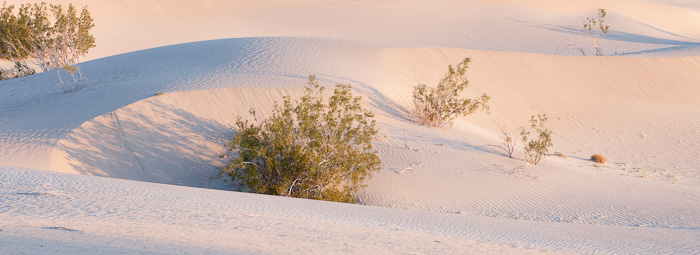
Canon 5D Mark II, Canon 70-200 2.8 IS II. 135mm, ISO 400, 1/160 sec @ f/8.0.
Sometimes the shots just don’t work out 🙂
On our second trip to the Mesquite Dunes, this time for sunrise, I was walking out among the dunes before the sun came up and saw a promising curve and bush. I looked at their position, looked at where the sun would rise, and figured if I waited patiently the sun would bathe them both in beautiful light.
So I grabbed my gear, hiked to the top of a dune, set up the camera on a tripod, and waited. And waited. And waited. 30 minutes in the freezing cold for the sun.
Then the sun came up, and I took the photo. And… it just wasn’t very good. What was a solitary bush nestled nicely in a curve was really a bush surrounded by other bushes. Perhaps if I had Photoshop CS5 with context-aware editing I could fix the photo *grin*. Alas, it was not to be.
Have you ever waited patiently for the right alignment of light and subject, only to realize after taking the shot it wasn’t as good as you thought it would be?

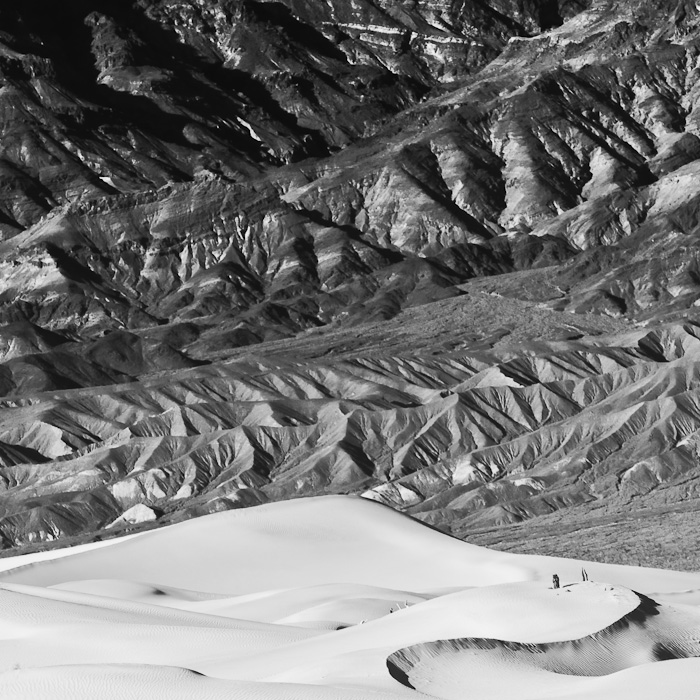
Canon 5D Mark II, Canon 70-200 f/2.8L IS II with 1.4x. 280mm, ISO 100, 1/250 sec @ f/8.0.
As promised in my previous post here’s a photo from the Mesquite Flat Dunes in Death Valley, CA. I was apprehensive about shooing here as the world doesn’t really need more photos of rippling sand rolling across dunes. We saw many of those during the portfolio review, some better than others, but to borrow a term from JP I was suffering from dune fatigue.
At any rate, when shooting the dune field I really tried hard not to photograph the dunes. Instead I worked to make the dunes a supporting act for something else in the frame.
The above photo was taken while shooting with Glenn, a friend from Antarctica last year. We saw this scene from about 20 minutes out when walking and spent our entire shoot in and around it. I have at least 20 frames of this little scene from various angles and distances. But the second was the best!
Have you ever photographed sand dunes? What did you do to make them special?


Canon 5D Mark II, Lensbaby Composer, zone plate optic. ISO 100, 1/15 sec @ f/19.
My apologies for the lack of posts from Death Valley, but the Internet is both flakey and I’ve been incredibly busy. If we’re not waking up at some ghastly time (4am yesterday, 4:30am today), we’re either shooting, reviewing, or eating.
Yesterday was a tough day for me personally. I just didn’t feel the vibe in the morning (Zabriski Point) and our afternoon location was sand dunes. Having shot White Sands National Monument in the past it was hard to get excited about more sand. I did try to make the best of it though by going for shots that were different than undulating dunes with ripples. You’ll have to wait until later blog entries to see what I came up with, but I was pleasantly surprised and the feedback from others was positive (far more so than the crap I shot at Zabriski Point).
This morning we shot Badwater. It was awesome. 4:30am was, in hindsight, half an hour too late to get up, but I managed to get a spectacular shot of sunrise. Again, you’ll have to wait for a later blog entry for details!
For sunset today we shot Artist’s Palette. I didn’t get it. Some people were super excited, but to me it was more sharp hills with some colour. It will be interesting to see what people came up with, because I only shot 63 frames and I’m pretty sure they’re all junk.
My big success today was with the Lensbaby (photo above). For the first time I knew what I wanted the outcome to be, knew what Lensbaby widget would do it, and knew what it would look like when it was done… before I took the photo. That’s the first time I’ve managed to do that with the Lensbaby, instead of just shooting around and hoping something works.
What I like most about the image is it takes a very stark and barren place and brings a touch of colour and fun to it. I was apprehensive about including the photo in the review over lunch today, but figured I’d spice things up. I’m glad I did, as the image was very well received.
That’s all from Death Valley for now. Time soon for dinner and then sleep.
Uuuugh. A 5am wake-up is never fun. But I’m safely at the airport waiting for my flight to Las Vegas for a four day photo workshop in Death Valley, NV, with John Paul Caponigro. It’ll be a reunion of sorts: at least four other people on the trip were also in Antarctica with me last year.
I’m really looking forward to shooting in the Southwest again, and having four dedicated days to do it without interruption. I’m also looking forward to getting critical feedback on photos, both from the trip and of prints I’m bringing with me for review. Several of the prints are part of the B&W square series I’m working on from the Washington coast.
It’s also a chance to test out some new gear. My workhorse backpack, a Tamrac Expedition 5, has been replaced with a new Clik Elite Escape. It’s the best I could find that would hold the gear I carry on a regular basis that included a cushioned hip strap. We’ll see how it works!
From a lens perspective this trip is exciting for two reasons: new lenses and borrowed lenses. On the new lens front my 70-200 f/2.8L IS II arrived yesterday, to replace my original model of the same lense. The 70-200 is my workhorse so I’m very excited to put the new version through its paces. I also caved and bought a Lensbaby Composer with soft focus and zone plate/pinhole optics. I blame David for this purchase, since he’s constantly lending me his when we head to the Washington Coast for photos. I also have a 17 TS-E on loan from lensrentals.com. I’m not expecting it’ll be used that often, but there will almost certainly be a few occasions where it’s a necessity.
So that’s the scoop. Hopefully I’ll have some Internet access while on the trip to post updates (assuming there is time between shooting, reviewing images, and eating!)
Have you ever gone to Death Valley? What was your experience?

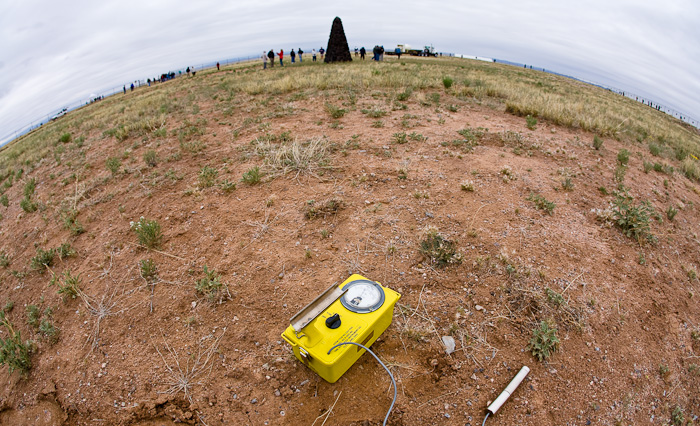
Canon 5D, 15mm f/2.8. ISO 100, 1/125 @ f/5.6.
I’m preparing for a trip to Death Valley, NV next week, and coincidentally I was chatting with Eleanor Brown about the American Southwest. The conversation and the upcoming trip reminded me of my trip to New Mexico three years ago for the spring visitation day at the Trinity Test Site.
The day we were there the weather was cold, grey, and generally awful. There was no good morning light, and the site itself is pretty stark. Honestly, from a photographic perspective, the site is pretty uninspiring. Of the shots I took there this is the only one I really thought worked. That’s our Geiger Counter in the foreground, showing 0.18 mr/hr.
If you are planning a trip to New Mexico in the spring or fall it’s worth checking to see if the Trinity site opening day is around your travel dates. They open the first Saturday in April and October, so this year that should be April 3rd and October 2nd. Your best bet is to spend the night in Soccoro, NM (there’s a nice Holdiay Inn Express there) and then drive to the Stallion Range Center to arrive and get in line by about 7:30. Do not do the caravan tours from Alamagordo!
Have you ever visited Trinity, or one of the other sites that were part of the Manhattan project?

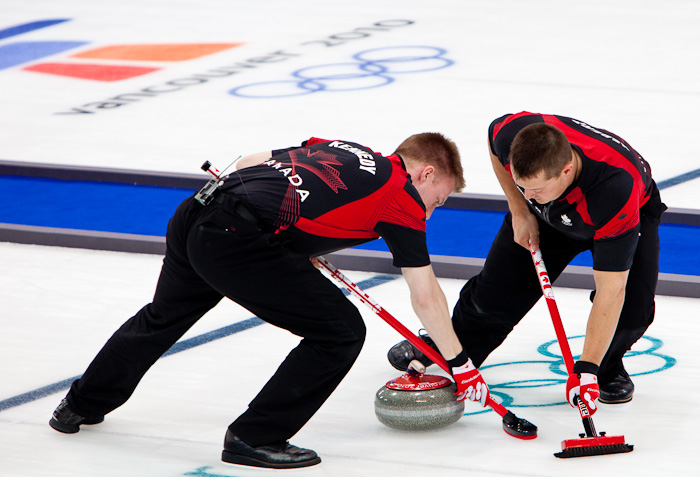
Canon 5D Mark II, 70-200 f/2.8L with 1.4x. 280mm, ISO 800, 1/250 @ f/5.6.
Something a little different today from the Olympics. We were at the Men’s Gold Medal curling game (yay Canada!) and had seats that were nice and close to the ice. The above photo is of Mr Kennedy and Mr Hebert, the best front-end in curling today. What I like most about this photo is the composition and cropping to keep the Olympic logo behind them, and how the logo is right under their feet. It’s always nice to see something like that at the event, take photos, and then find out later during processing it worked!
One other note about the photos I took at the Olympics: manual mode on a camera is awesome. It is very easy to fall into the trap of only using aperture- or shutter-priority mode on the camera, but when you are under fixed lighting conditions manual mode is a must. I did some test shots prior to the actual curling events to lock on my shutter speed, aperture, and ISO, then saved them as “C3” on my dial. I did similar tests for shooting the crowd in the stands and saved them as “C1” on my dial. I could then shoot with complete freedom knowing that the exposure would be exactly the same across all my images. If I changed subjects, a quick flip of the dial meant I had exactly the right settings ready to go.
It made post processing a breeze as well: in almost every case a direct cut-and-paste of exposure settings could be applied to all the images.
Have you ever used manual mode on your camera at a major event? How did it work out for you?

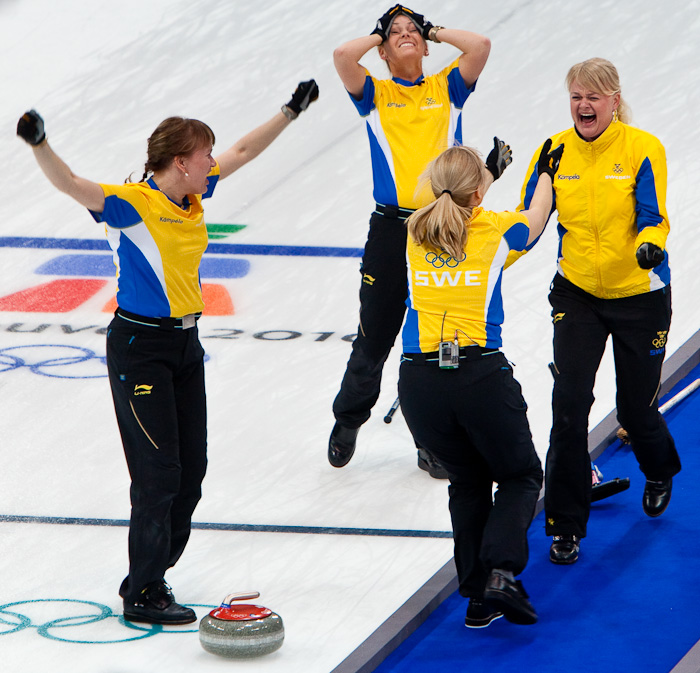
Canon 5D Mark II, 70-200 f/2.8L with 1.4x. 220mm, ISO 800, 1/250 @ f/5.6.
We attended the medal rounds of women’s curling today at the Olympics. Curling is a sport near and dear to my heart, as I’ve curled for several years at the Granite Curling Club. It’s actually a pretty boring sport to photograph though. You have to spend a lot of time and energy trying to capture the little things players do between shots to add some variety to the photos. Otherwise you wind up pictures of butts, sweepers, and some yelling. Especially when you don’t have on-ice access like we had for the 2007 USCA Junior Curling Championships.
One shot to get, however, is the faces of the team that wins the gold medal. Even if it isn’t Canada, like you hope. It’s hard to be too sad when you see the look of joy on the faces of the winners.
Have you ever shot the finals of a sporting event? What kind of images did you get that captured the moment of victory (or defeat)?















